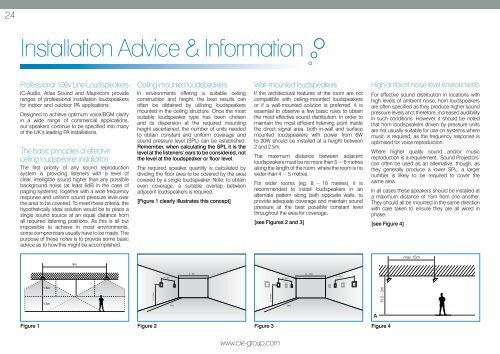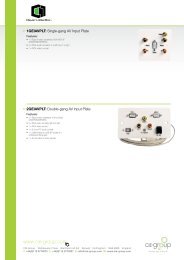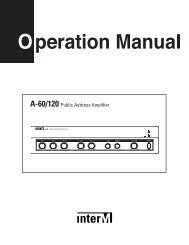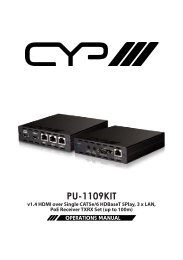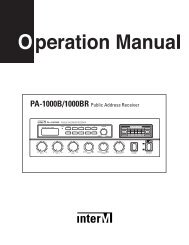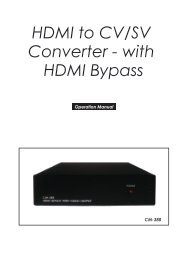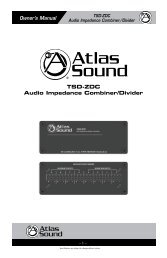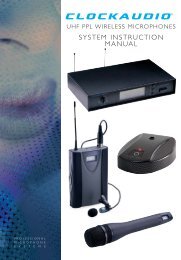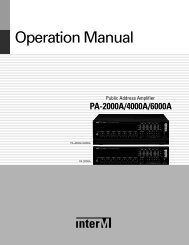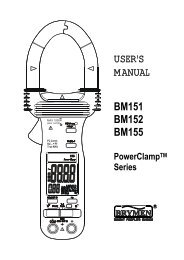Professional 100v Line Loudspeaker Solutions - CIE-Group
Professional 100v Line Loudspeaker Solutions - CIE-Group
Professional 100v Line Loudspeaker Solutions - CIE-Group
Create successful ePaper yourself
Turn your PDF publications into a flip-book with our unique Google optimized e-Paper software.
24<br />
Installation Advice & Information<br />
<strong>Professional</strong> <strong>100v</strong> <strong>Line</strong> <strong>Loudspeaker</strong>s<br />
IC-Audio, Atlas Sound and Majorcom provide<br />
ranges of professional installation loudspeakers<br />
for indoor and outdoor PA applications.<br />
Designed to achieve optimum voice/BGM clarity<br />
in a wide range of commercial applications,<br />
our speakers continue to be specified into many<br />
of the UK’s leading PA installations.<br />
The basic principles of effective<br />
ceiling loudspeaker installation<br />
The first priority of any sound reproduction<br />
system is providing listeners with a level of<br />
clear, intelligible sound higher than any possible<br />
background noise (at least 6dB in the case of<br />
paging systems), together with a wide frequency<br />
response and uniform sound pressure level over<br />
the area to be covered. To meet these criteria, the<br />
hypothetically ideal solution would be to place a<br />
single sound source at an equal distance from<br />
all required listening positions. As this is all but<br />
impossible to achieve in most environments,<br />
some compromises usually have to be made. The<br />
purpose of these notes is to provide some basic<br />
advice as to how this might be accomplished.<br />
Ceiling-mounted loudspeakers<br />
In environments offering a suitable ceiling<br />
construction and height, the best results can<br />
often be obtained by utilising loudspeakers<br />
mounted in the ceiling structure. Once the most<br />
suitable loudspeaker type has been chosen<br />
and its dispersion at the required mounting<br />
height ascertained, the number of units needed<br />
to obtain constant and uniform coverage and<br />
sound pressure level (SPL) can be established.<br />
Remember, when calculating the SPL it is the<br />
level at the listeners’ ears to be considered, not<br />
the level at the loudspeaker or floor level.<br />
The required speaker quantity is calculated by<br />
dividing the floor area to be covered by the area<br />
covered by a single loudspeaker. Note; to obtain<br />
even coverage, a suitable overlap between<br />
adjacent loudspeakers is required.<br />
[Figure 1 clearly illustrates this concept]<br />
Wall-mounted loudspeakers<br />
If the architectural features of the room are not<br />
compatible with ceiling-mounted loudspeakers<br />
or if a wall-mounted solution is preferred, it is<br />
essential to observe a few basic rules to obtain<br />
the most effective sound distribution. In order to<br />
maintain the most efficient listening point inside<br />
the direct signal area, both in-wall and surface<br />
mounted loudspeakers with power from 6W<br />
to 20W should be installed at a height between<br />
2 and 2.5m.<br />
The maximum distance between adjacent<br />
loudspeakers must be no more than 5 ~ 6 metres<br />
along the length of the room, where the room is no<br />
wider than 4 ~ 5 metres.<br />
For wider rooms (eg. 8 ~ 10 metres), it is<br />
recommended to install loudspeakers in an<br />
alternate pattern along both opposite walls, to<br />
provide adequate coverage and maintain sound<br />
pressure at the best possible constant level<br />
throughout the area for coverage.<br />
[see Figures 2 and 3]<br />
High ambient noise level environments<br />
For effective sound distribution in locations with<br />
high levels of ambient noise, horn loudspeakers<br />
are often specified as they produce higher sound<br />
pressure levels and, therefore, increased audibility<br />
in such conditions. However, it should be noted<br />
that horn loudspeakers driven by pressure units<br />
are not usually suitable for use on systems where<br />
music is required, as the frequency response is<br />
optimised for voice reproduction.<br />
Where higher quality sound and/or music<br />
reproduction is a requirement, ‘Sound Projectors’<br />
can often be used as an alternative, though, as<br />
they generally produce a lower SPL, a larger<br />
number is likely to be required to cover the<br />
same area.<br />
In all cases these speakers should be installed at<br />
a maximum distance of 15m from one another.<br />
They should all be mounted in the same direction<br />
with care taken to ensure they are all wired in<br />
phase.<br />
[see Figure 4]<br />
A<br />
Figure 1<br />
Figure 2 Figure 3 Figure 4<br />
www.cie-group.com


